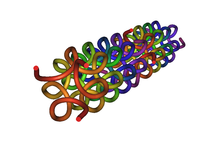- Collagen helix
-
Collagen triple helix 
Model of a collagen helix.[1] Identifiers Symbol Collagen Pfam PF01391 InterPro IPR008160 SCOP 1a9a Available protein structures: Pfam structures PDB RCSB PDB; PDBe PDBsum structure summary  TEM image of collagen fibres.
TEM image of collagen fibres.
In collagen, the collagen helix, or type-2 helix, is a major shape in secondary structure. It consists of a triple helix made of the repetitious amino acid sequence glycine - X - Y, where X and Y are frequently proline or hydroxyproline.[2] Each of the three chains is stabilized by the steric repulsion due to the pyrrolidine rings of proline and hydroxyproline residues. The pyrrolidone rings keep out of each other’s way when the polypeptide chain assumes this extended helical form, which is much more open than the tightly coiled form of the alpha helix. The three chains are hydrogen bonded to each other. The hydrogen bond donors are the peptide NH groups of glycine residues. The hydrogen bond acceptors are the CO groups of residues on the other chains. The OH group of hydroxyproline also participates in hydrogen bonding. The rise of the collagen helix (superhelix) is 2.9 Å (0.29 nm) per residue.
References
- ^ Berisio R, Vitagliano L, Mazzarella L, Zagari A (February 2002). "Crystal structure of the collagen triple helix model [(Pro-Pro-Gly)(10)(3)"]. Protein Sci. 11 (2): 262–70. doi:10.1110/ps.32602. PMC 2373432. PMID 11790836. http://www.pubmedcentral.nih.gov/articlerender.fcgi?tool=pmcentrez&artid=2373432.
- ^ Bhattacharjee A, Bansal M (March 2005). "Collagen structure: the Madras triple helix and the current scenario". IUBMB Life 57 (3): 161–72. doi:10.1080/15216540500090710. PMID 16036578.
Protein secondary structure Protein secondary structure Helices: α-helix · 310 helix · π-helix · β-helix · Polyproline helix · Collagen helix
Extended: β-strand · Turn · Beta hairpin · Beta bulge · α-strand
Supersecondary: Coiled coil · Helix-turn-helix · EF handAmino acids Helix-favoring: Methionine · Alanine · Leucine · Glutamic acid · Glutamine · Lysine
Extended-favoring: Threonine · Isoleucine · Valine · Phenylalanine · Tyrosine · Tryptophan
Disorder-favoring: Glycine · Serine · Proline · Asparagine · Aspartic acid
No preference: Cysteine · Histidine · Arginine←Primary structureTertiary structure→
This protein-related article is a stub. You can help Wikipedia by expanding it.
